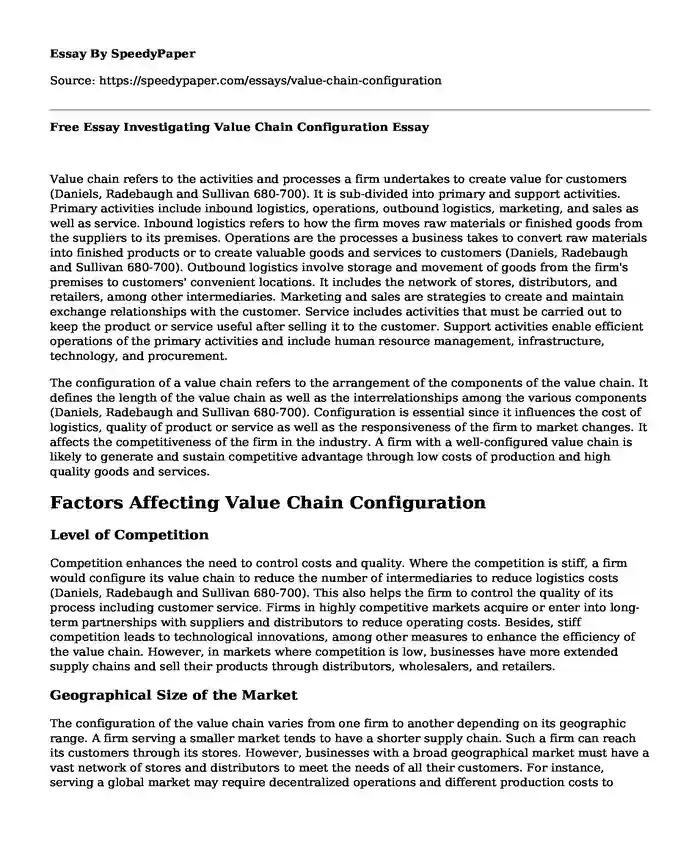
| Type of paper: | Essay |
| Categories: | Supply chain management |
| Pages: | 3 |
| Wordcount: | 716 words |
Value chain refers to the activities and processes a firm undertakes to create value for customers (Daniels, Radebaugh and Sullivan 680-700). It is sub-divided into primary and support activities. Primary activities include inbound logistics, operations, outbound logistics, marketing, and sales as well as service. Inbound logistics refers to how the firm moves raw materials or finished goods from the suppliers to its premises. Operations are the processes a business takes to convert raw materials into finished products or to create valuable goods and services to customers (Daniels, Radebaugh and Sullivan 680-700). Outbound logistics involve storage and movement of goods from the firm's premises to customers' convenient locations. It includes the network of stores, distributors, and retailers, among other intermediaries. Marketing and sales are strategies to create and maintain exchange relationships with the customer. Service includes activities that must be carried out to keep the product or service useful after selling it to the customer. Support activities enable efficient operations of the primary activities and include human resource management, infrastructure, technology, and procurement.
The configuration of a value chain refers to the arrangement of the components of the value chain. It defines the length of the value chain as well as the interrelationships among the various components (Daniels, Radebaugh and Sullivan 680-700). Configuration is essential since it influences the cost of logistics, quality of product or service as well as the responsiveness of the firm to market changes. It affects the competitiveness of the firm in the industry. A firm with a well-configured value chain is likely to generate and sustain competitive advantage through low costs of production and high quality goods and services.
Factors Affecting Value Chain Configuration
Level of Competition
Competition enhances the need to control costs and quality. Where the competition is stiff, a firm would configure its value chain to reduce the number of intermediaries to reduce logistics costs (Daniels, Radebaugh and Sullivan 680-700). This also helps the firm to control the quality of its process including customer service. Firms in highly competitive markets acquire or enter into long-term partnerships with suppliers and distributors to reduce operating costs. Besides, stiff competition leads to technological innovations, among other measures to enhance the efficiency of the value chain. However, in markets where competition is low, businesses have more extended supply chains and sell their products through distributors, wholesalers, and retailers.
Geographical Size of the Market
The configuration of the value chain varies from one firm to another depending on its geographic range. A firm serving a smaller market tends to have a shorter supply chain. Such a firm can reach its customers through its stores. However, businesses with a broad geographical market must have a vast network of stores and distributors to meet the needs of all their customers. For instance, serving a global market may require decentralized operations and different production costs to lower logistics costs.
Nature of the Product or Service
The nature of the product influences the type of manufacturing processes required as well as the cost of setting up a plant. Highly technical products such as machinery require controlled production processes. Besides, setting up a plant for such products is expensive. Businesses producing complicated goods have centralized production processes. For instance, cars and smartphone manufacturers have centralized design operations although some of their manufacturing plants are widely distributed.
Human Resource Skills and Technological Capabilities
Human resource skills, technological ability and financial stability of a firm determines whether it produces in-house or outsources the manufacturing of its products. A firm with highly skilled employees and sufficient financial resources can produce in-house. However, businesses with limited resources may outsource the production of their goods. These factors also influence the firm's ability to use modern technology in its value chain.
Conclusion
The configuration of the value chain is critical to creating and sustaining competitive advantage. Firms with efficient value chains are more competitive than those with ineffective value chains. A business should consider factors like the size of its market, technical and human resource abilities, level of competition and nature of the product or service when configuring the supply chain. The target of the configuration should be to reduce costs and improve the quality of products and services.
Work cited
Daniels, John, Lee Radebaugh, and Daniel Sullivan. International Business. 13th ed. Pearson, 2011. Print.
Cite this page
Free Essay Investigating Value Chain Configuration. (2022, Apr 05). Retrieved from https://speedypaper.com/essays/value-chain-configuration
Request Removal
If you are the original author of this essay and no longer wish to have it published on the SpeedyPaper website, please click below to request its removal:
- Free Essay about Education for People with Disabilities
- Comparison Essay Sample: Jane Eyre by Charlotte Bronte and the myth of Cupid Psyche
- Free Essay about Cognitive-Behavioral Therapy Techniques
- Navigation Plan Essay, Free Example for You
- Incidents in the Life of a Slave Girl - Book Review Essay Example
- Essay Sample on Social Structure Increases Crime Rates in Our Societies
- Free Essay: Major Attributes of the Portrayal of Nature in W. Wordsworth's Poetry
Popular categories




